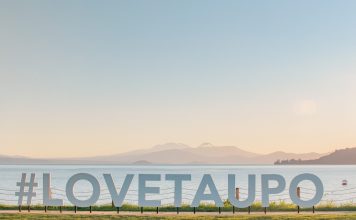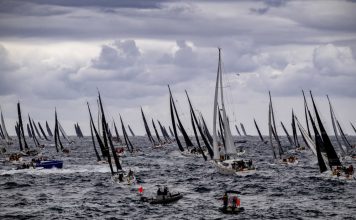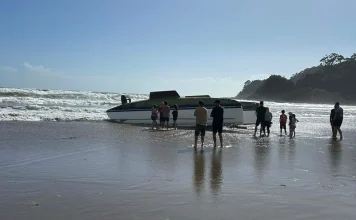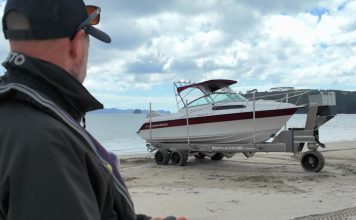When we arrived on a bright, sunny Sunday morning, the Parker 920 Explorer Max was tied up to the jetty beside Richard and Suzie Wardenburg’s Pauanui Waterways home, all ready to go. The Wardenburgs are the New Zealand representatives for Parker, a brand that is perhaps still relatively unknown in New Zealand, but with a global presence that’s particularly strong in its native Europe.
The Polish-built Parker range starts at 6.6m and includes a variety of centre-console, cabin, pilothouse and weekender models, right up to the 11.2m Monaco in sedan and flybridge versions. Based on the popular 790 Explorer, but extended aft, the 9.95m 920 Explorer Max is one of the company’s bigger models, benefitting from a vast cockpit with an extremely versatile modular layout.

The 920 Max is rated for up to 450hp, in single or twin outboards. Parker recommends twin 200hp or 225hp outboards for this model, or a single 400hp. Richard has gone one better, fitting a Mercury Racing 450R, a supercharged, performance-oriented 450hp V8 engine. With a 17-inch propeller, it drives the big Parker to a top speed of close to 45 knots.
Full of fuel (500l) and water (100l), we left the dock with seven adults onboard, cruising down the harbour before crossing a reasonably flat Pauanui Bar. Once clear, Richard opened the taps and the Parker surged off towards the Aldies clearly visible on the horizon.
The 920 Explorer Max was conceived as a multi-role vessel: a day boat, fast commuter, sportfisher (bait board, rod holders and rocket launcher were added in New Zealand), and a weekender. With engine-heated hot water, Wallas diesel heating, a useful galley with diesel cooking, an inverter, fridge, solar charging, ample freshwater, a separate head compartment, cockpit shower and sleeping accommodation for up to five (seven with the cockpit enclosed), a weekend on the water should be pretty comfortable.
The Parker’s underwater profile is somewhat unusual. There are two steps moulded into the hull, designed to lessen water drag once the boat is planning. It’s a feature I tend to associate with high-performance or racing hulls, but steps are becoming relatively common in large volume recreational powerboats as well. Many of Parker’s larger models have stepped hulls.

This vessel certainly doesn’t lack for performance. Richard attributes the broad sweet spot, from 20 knots to 31 knots where the Mercury burns less than three litres per nautical mile, to its stepped hull. Even at 6000rpm and 42 knots, the fuel burn is under four litres per nautical mile. And this is with a performance racing engine where fuel economy is not top of the priorities list.
Although the boat goes well with the 450R, Richard is looking forward to fitting one of Mercury’s new 400hp V10 engines to his next boat. The V10 is slightly heavier and has a more robust bottom end swinging a larger propeller, so cavitation should be minimal. The V10 offers more torque, too, which should benefit overall tractability, and make hole-shots even more impressive than they already are.
The extra weight aft should improve the boat’s overall balance as well, resulting in drier running characteristics. With (heavier) twin engines on the transom, Richard told us the 920 responds better to outboard trim inputs and travels with a slightly more bow-up attitude. As reviewed with a single 450hp, the boat planes almost perfectly level, even with the outboard trimmed well out, so it throws a bit of spray over the bow in bigger seas. That said, nestled inside the enclosed wheelhouse behind a business-like reverse sheer windscreen equipped with large wiper-washers, the odd bit of spray is hardly an issue.

The cabin doesn’t look overly large, especially in relation to the vessel’s vast cockpit – it’s the same one as fitted to the 790 Explorer – but it feels spacious enough inside. Light and bright with good visibility in every direction, it benefits from twin skylights (with covers), the largest sliding open, ventilators and LED downlights in the ceiling. Opening side-windows and aluminium and glass doors to the cockpit complete the picture.

The wheelhouse layout is conventional: helm and galley to starboard and a raised dinette to port, the front seat with a reversible backrest. Hardwearing Sunbrella upholstery fabric in grey is used inside and out, complemented by matching cushions, grey and white gelcoat and black accents, including the galley’s countertop. Drop the table down and the dinette converts to double berth, complementing the angled double berth in the bow (skylight and side windows) and a single berth tucked fore and aft under the saloon sole. There’s also a compact enclosed heads compartment with engine heated hot water for the shower.

The Parker 920 is a fast cruiser, so it wasn’t long before the tall cliffs of the Aldermen Islands were looming over us. Once we’d got away from the lifting swells close to the bar, the rest of the trip was comfortably undertaken at 30 knots-plus. The helm position is good, with a supportive seat and a fold-up bolster for driving standing up and a well-designed console with space for the 15-inch Simrad MFD and assorted gauges, switches and controls. The VHF is located close at hand under the drive by wire throttle control on the driver’s right.
The 920’s ride is generally smooth, and quiet too with the saloon doors closed. And since the helm position is relatively far forward, the best ride of all is lounging on one of the cockpit seats, which can be included or left at home as required – and arranged any way you like inside the boat’s 5.5m2 cockpit.
So too for the pair of cockpit tables. On our day out we used just one table with the seat modules wrapping around one side of the cockpit. The tables and any other large objects can be stored in the huge underfloor locker/lazarette and there are generous wet lockers/fish lockers under the sole as well, six in total. The seat modules also provide excellent storage.

If sport fishing is your thing, there’s a large 150-litre ice or fish tank in the transom and one or more underfloor lockers can also be turned into live wells – all the plumbing is pre-installed at the factory. As reviewed, the bait board covers the transom live well, but the whole unit hinges from the rear to access it. The cockpit also has an additional transom locker, both salt and freshwater washdown, and a shorepower connection; an inverter takes care of the boat’s 240V needs while at sea.
We enjoyed a bit of fishing, both from inside the cockpit and from the platforms either side of the outboard. These are wide and deep enough to feel quite secure in calm conditions. The boarding/dive ladder and the transom door are on the starboard side, as is the washdown hose which extends from its own locker next to the saloon bulkhead. The cockpit with its deep locker drains empties directly overboard.

The cockpit’s not only great for fishing (or diving, or hauling pots, or deploying paddleboards…) it’s also the perfect place for a bit of al fresco dining and socialising. With such a versatile modular seating layout, and the choice of up to two tables, it easily accommodates a good-sized party – we had no issues serving a tasty lunch onboard for seven. The cabin top overhang provides a bit of cockpit shade and a full canopy supported on a frame, with side screens, for all seasons boating. The cabin roof also supports the custom rocket launcher, Juice solar panels for the house batteries (two) and floodlighting for the foredeck.

The foredeck is the spot for a bit of sun lounging, which some of the younger women enjoyed while we were tucked in one or other of the Aldermen Islands’ many sheltered coves. Access forward is easy, with plenty or handrails, plus a raised bulwark and wrap-around railings for security. Anchoring can be done remotely from the helm or from the bow. There’s deep anchor locker stowage with excellent fall thanks to the Parker’s plumb-type bow profile above the waterline. This vessel is equipped with a Maxwell capstan, Rocna anchor, 50m of chain and 100m of warp.

The run back to Pauanui was pleasantly comfortable with the seas mostly on the aft quarter. Cruising at an economical 30 knots, we covered the distance in no time and had the boat secured to the Wardenburg’s jetty well in time for evening drinks and hors d’ouevres on the patio overlooking the canal. Berthing was facilitated by the Parker’s bowthruster. While the Wardenburgs haul the boat out on a trailer for longer term storage, it’s big for trailering on the road (but not impossibly so with the right trailer and vehicle), but perfect for drystack or hardstand storage. Parker offers several trailerable models.
All in all, the Parker 920 Explorer Max impresses as a distinctive looking boat with a hugely spacious cockpit and a wonderfully versatile layout. Build quality appears to be very good and the styling is modern and unmistakably European. Fast and capable, the Parker is a vessel that can fill any one of a variety of roles, or several different roles, depending on the owner’s desires on the day. With the new Mercury V10, it will probably be even better.














